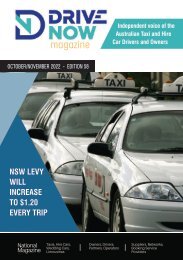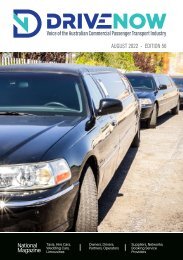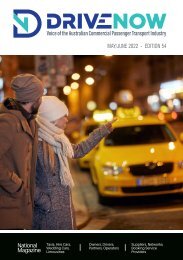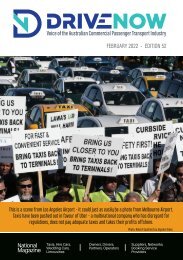DRIVE NOW August 2021
*** SCROLL DOWN TO SELECT ALTERNATIVE MAGAZINE EDITIONS *** Australia's only Magazine for the Commercial Passenger Transport Industry. News and views for Drivers, Owners and Operators of Taxi, Hire Car, Limousine, Ride Share, Booked Hire Vehicles, Rank and Hail Cars.
*** SCROLL DOWN TO SELECT ALTERNATIVE MAGAZINE EDITIONS ***
Australia's only Magazine for the Commercial Passenger Transport Industry. News and views for Drivers, Owners and Operators of Taxi, Hire Car, Limousine, Ride Share, Booked Hire Vehicles, Rank and Hail Cars.
Create successful ePaper yourself
Turn your PDF publications into a flip-book with our unique Google optimized e-Paper software.
Disability<br />
Etiquette<br />
by<br />
Communicating with a person with<br />
disability can seem daunting to<br />
some. Some people are concerned<br />
that they will embarrass themselves<br />
or a person with disability by saying<br />
or doing the wrong thing. Though<br />
these concerns usually come<br />
from a good place, it is entirely<br />
unnecessary. The most important<br />
thing to remember is to treat each<br />
person with respect.<br />
It is important to remember that<br />
everyone is different and will have<br />
their own preferences. When<br />
communicating with a person with<br />
disability, you should ask the person<br />
what works for them, and respect<br />
their wishes.<br />
Basic tips<br />
Avoid asking personal questions<br />
about someone's disability.<br />
Be considerate of the extra time it<br />
might take for a person to do or say<br />
something.<br />
Be polite and patient when offering<br />
assistance, and wait until your offer<br />
is accepted. Listen or ask for specific<br />
instructions. Be prepared for your<br />
offer to be refused.<br />
Relax. Anyone can make mistakes.<br />
Offer an apology if you feel you’ve<br />
caused embarrassment. Keep a<br />
sense of humour and be willing to<br />
communicate.<br />
Speaking or writing<br />
Refer to a person's disability only<br />
when necessary and appropriate.<br />
Refer to the individual first, then<br />
to their disability (for example,<br />
“person with disability," rather than<br />
"disabled person").<br />
The following terms should be<br />
avoided because they can have<br />
negative meanings: invalid, ablebodied,<br />
wheelchair-bound, victim,<br />
crippled, defect, suffers from,<br />
handicap, a patient.<br />
Face to face<br />
communication<br />
Use a normal tone of voice when<br />
welcoming a person with disability.<br />
Do not raise your voice unless you<br />
are asked to.<br />
Look and speak directly to the<br />
person with disability, not just to<br />
the people accompanying them,<br />
including interpreters.<br />
Be patient and give your undivided<br />
attention, especially with someone<br />
who speaks slowly or with great<br />
effort.<br />
Never pretend to understand what<br />
a person is saying if you don’t. Ask<br />
the person to repeat or rephrase, or<br />
offer them a pen and paper.<br />
If requested to by the individual,<br />
offer a person who is blind or has<br />
low vision your elbow or shoulder,<br />
to guide rather than propel them.<br />
18 <strong>August</strong> <strong>2021</strong>

















